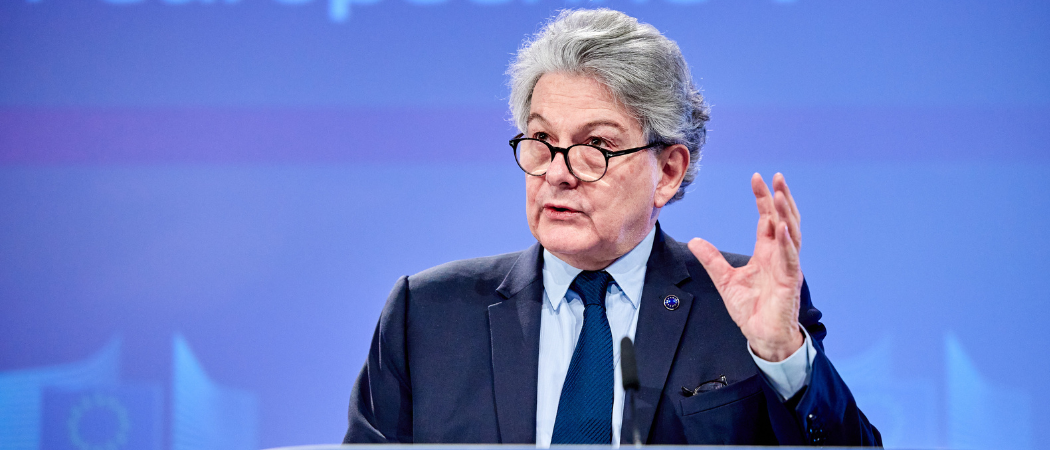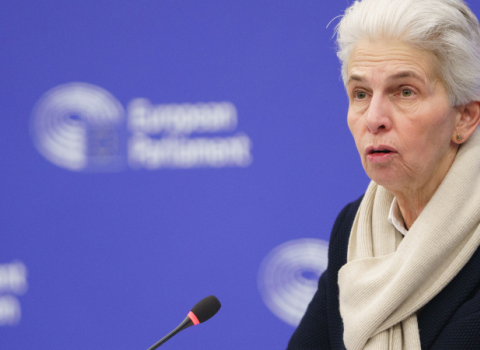A €1.5B fund will help to scale up research projects and build supply chains, while a new legal structure will enable member states to facilitate cooperation across the whole life cycle of defence capabilities

Thierry Breton, European Commissioner for Internal Market, speaking at a press conference today on the European Defence Industrial Strategy. Photo: Claudio Centonze / European Union
The European Commission has announced a legislative proposal to boost the EU defence industry, including a plan for translating research results stemming from the European Defence Fund (EDF) into military applications, in a bid to reduce dependence on arms imports and to ensure technological superiority in future conflicts.
The proposed European Defence Industry Programme (EDIP) is intended to transform short-term emergency measures adopted in 2023 to support the EU defence sector, into a long-term policy for the industry.
EDIP is part of the EU’s first-ever European Defence Industrial Strategy (EDIS) announced on Tuesday, which sets out actions to support the competitiveness and readiness of the EU’s defence industry, and calls on member states to work together on the EU’s defence readiness, from research and development, through to procurement.
If approved, EDIP will ensure continuous support to the European defence technology and industrial base and help the bloc respond faster to military threats looming from Russia.
Russia’s invasion of Ukraine and Washington’s reluctance to send more military aid to Kyiv, have forced EU leaders to think more about defence and how the 27 member states can coordinate better, both among themselves and with NATO, on developing new military technologies, including interoperable weapons and ammunitions.
“With the return of high intensity conflict on our continent, Europe cannot wait any longer to strengthen the European defence technological and industrial base’s ability to produce more and faster,” said Thierry Breton, EU commissioner for the internal market.
But Jan Pie, secretary general of the Aerospace, Security and Defence Industries Association of Europe (ASD) said it is unclear whether the member states will reach a consensus on the financial commitment needed for the strategy to work. “The success of EDIS and EDIP will now depend very much on member states’ reaction. Speed and financial resources will be crucial for their implementation,” he said.
These priorities were outlined by EU Commission president Ursula von der Leyen in a speech in the European Parliament last week. “Europe should strive to develop and manufacture the next generation of battle-winning operational capabilities,” she told MEPs in Strasbourg ahead of a debate on strengthening European defence.
Von der Leyen wants to appoint a defence commissioner in the next administration if she is re-appointed as EU Commission president following the European elections in June. Recent polls indicate the European People’s Party (EPP) is poised to win enough seats to secure a second von der Leyen term at the helm of the Commission.
“Since time is of essence, we hope in particular that the forthcoming European elections will not significantly slow down the legislative procedure for EDIP,” said Pie.
Collaborative defence R&D
According to a joint document setting out the details of the new EU defence strategy, the European Commission, Parliament and Council agree that member states will have to work together on defence R&D. “Collaborative research, development and procurement of defence equipment should progressively become the norm in the EU,” the document says.
In addition, “To remain competitive, the capacity and autonomy to develop innovative defence products must also be underpinned by support for research into future-proof defence capabilities, including in disruptive technologies,” the new strategy says.
The EU should also provide start-ups, SMEs and research and technology organisations “more flexible, faster and leaner funding cycles and facilitate better connections with military end-users and investors.”
In support of this, the Commisison is also planning for a €2 billion EU Defence Innovation Scheme (EUDIS), as a subsidiary of the EDF. Running to 2027, this scheme will help R&D organisations and SMEs find investors, partners and buyers. The Commission is also exploring the introduction of “ever-warm” calls for projects and other ways to speed up the transfer of civilian technologies to defence applications.
Overall, EDF is investing more than €1 billion every year to boost defence industrial cooperation and incentivise cross-border defence research and development. However, according to the Commission, these projects quickly reach a commercialisation gap at the prototyping stage, partly because of the cacophony of regulations on military procurement across 27 member states.
The new strategy foresees a new Structures for European Armament Programme (SEAP) which would help bridge that gap and help maximise the uptake of technologies developed with EDF money.
The European Investment Bank (EIB) is also “ready to do more and better” to contribute to defence projects, its president Nadia Calviño announced last month.
Earlier this year, the Commission launched a consultation on opening Horizon Europe to dual use technologies with civil and military applications. The EU’s main research programme has been exclusively civilian for four decades, but the war in Ukraine has prompted the Commission to put forward three options for how the framework programme could contribute to defence R&D.
Several technical universities across Europe are working on a joint statement on this issue, which is due to be published in the coming weeks. Universities in a some EU countries are sceptical about abandoning civilian clauses, while others have been working closely with the defence sector for decades. It’s unclear if the war in Ukraine and the new EU strategy will change their minds.





 A unique international forum for public research organisations and companies to connect their external engagement with strategic interests around their R&D system.
A unique international forum for public research organisations and companies to connect their external engagement with strategic interests around their R&D system.